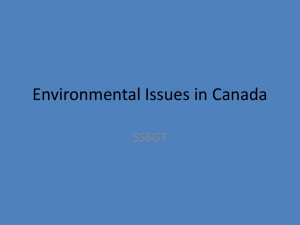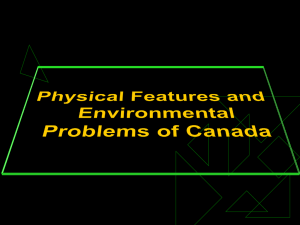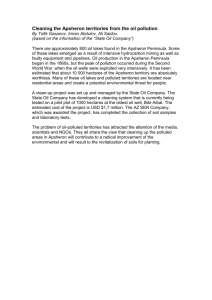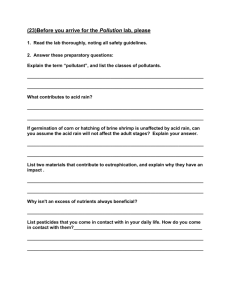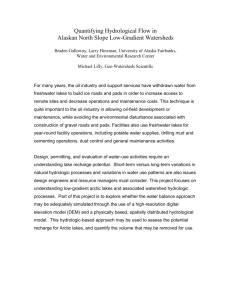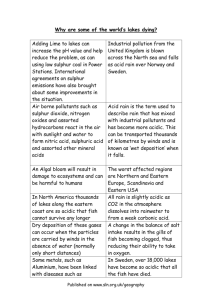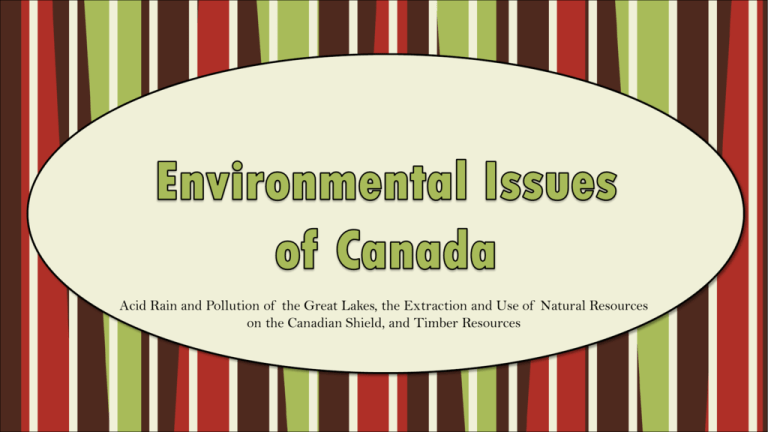
Acid Rain and Pollution of the Great Lakes, the Extraction and Use of Natural Resources
on the Canadian Shield, and Timber Resources
Standards
SS6G7 The student will discuss environmental issues in
Canada.
a. Explain the major environmental concerns of Canada
regarding acid rain and pollution of the Great Lakes, the
extraction and use of natural resources on the Canadian
Shield, and timber resources.
Teachers
Print off the following slide for each student.
They should complete the chart while
discussing the presentation.
Acid Rain and Pollution of the Great Lakes, the Extraction and Use of Natural Resources
on the Canadian Shield, and Timber Resources
• Coal-burning factories, cars, & trucks release chemicals
that pollute the air.
• The pollutants mix with water molecules in clouds
and turn the water acidic.
• High levels of acid in rain can damage or kill trees and
pollute lakes enough to kill fish.
• Houses, buildings, and statues can also be damaged.
• Southern Canada (near the Great Lakes region)
experiences the highest levels of acid rain.
• 50-75% of the pollution that causes acid rain actually
comes from the US.
• Wind patterns tend to move the pollution from the
US north into Canada.
• Canada’s government has done several things to reduce
pollution:
• They are building factories that don’t pollute the air.
• Laws have been passed that require cars to produce
less pollution.
• They are encouraging people to walk or ride
bikes/buses, rather than driving.
• In the 1970s, the Great Lakes had high levels of water pollution.
• Fishing was unsafe; tons of animals and plants were harmed or
killed.
• Factories around the region used the lakes as a place to dump wastes.
• Factories also used the chemical phosphorus when producing things
like toothpaste, fertilizer, pesticides, detergents, etc.
• This was really bad for lakes because it caused a rapid increase in
algae.
• In 1971, the Great Lakes Water Quality Agreement was signed
by US and Canada (renewed in 2002).
• The goal was to restore the lakes’ environment and to prevent
further damage.
o The countries are working together to reduce the amount
of human wastes dumped in lakes.
o They’re working to make sure that chemicals (like
phosphorus) are not put into lakes.
• The Canadian Shield is a large area of thin, rocky soil that
surrounds the Hudson Bay.
• Beneath the soil is one of Canada’s most valuable resources:
minerals (gold, silver, copper, zinc, lead, iron ore, uranium, &
nickel).
• Mineral deposits are very important to Canada’s economy
because they provide jobs.
• 1.5 million people make their living in the mining industry in
this area.
• Blasting & digging with heavy machinery causes the
land around mines to be damaged and the environment
is often ruined.
• Slag, or leftover rock from the smelting process, is often
dumped in any convenient place.
• Mining processes release harmful chemicals into the air,
which causes acid rain.
• Canada’s government has made new rules
about mining.
• Some rules reduce the amount of pollution
allowed in waterways.
• The government hopes to keep its fish
alive and safe to eat.
• With almost half its land covered in forests, Canada is a
leading producer of timber products.
• These products include lumber, paper, plywood, and
wood pulp.
• The major timber-producing provinces include British
Columbia, Quebec, and Ontario.
•
Citizens are concerned that logging is destroying the forests.
•
Most timber companies cut all the trees in a given area, leaving large treeless gaps
in the forest (called “clear-cutting”).
• This reduces water quality, causes erosion, & kills animals’ habitats.
• Heavy machinery leaves the forest floor compacted and makes it hard for new
growth to start.
•
•
Cutting trees down quicker than they can be re-grown is called
“deforestation”.
Trees are a limited resource.
• If they continue to be overused, they will not be renewed.
• Government and industries are working together to manage use
of the forests.
• Hundreds of millions of seedlings are planted each year.
• Billions of dollars are spent on managing and protecting the
forests.
• Over $100 million is spent each year by the logging industry
to protect wildlife & their habitats.
Teacher Directions – “In My Opinion” Ticket Out the
Door
Have the students write down their opinions about one
(or all) of Canada’s Environmental Concerns. The key is
to have them explain why they feel this way.
*There are two per page.
What’s your opinion about the topic of today’s
lesson? Why do you feel this way? Briefly explain.
What’s your opinion about the topic of today’s
lesson? Why do you feel this way? Briefly explain.
Teachers
I give my students the following handout at the beginning of our Canada unit. I tell
them to keep it handy in their Interactive Notebook, and whenever we discuss any
words that begin with certain letters, they are to write them down. The first person to
complete the chart wins a prize. *The words have to be things that we’ve discussed in
class, not things that they already know, so they must always pay attention!
Teachers
Thank you for downloading this file. I hope you enjoy using it with your students, and
I can’t wait to read your feedback in my TPT store!
• For more social studies materials, please visit my store:
http://www.teacherspayteachers.com/Store/Brain-Wrinkles
• I teach Language Arts and Social Studies in Georgia, so my products are aligned
with Common Core (LA) and Georgia Performance Standards (SS).
© Copyright 2013. Brain Wrinkles. All rights reserved. Permission is granted to copy pages specifically designed for student or
teacher use by the original purchaser or licensee. The reproduction of any other part of this product is strictly prohibited.
Copying any part of this product and placing it on the Internet in any form (even a personal/classroom website) is strictly
forbidden. Doing so makes it possible for an Internet search to make the document available on the Internet, free of charge, and is
a violation of the Digital Millennium Copyright Act (DMCA).
Credits:
All photos were found via Creative Commons and labeled for reuse.
• Fonts:
• Backgrounds & Graphics:


